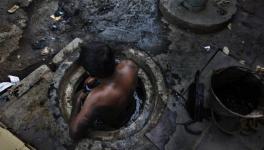5 Sanitation Workers from Bihar Suffocate to Death in Ghaziabad

Representational image.
Five sanitation workers, who travelled from Samastipur in Bihar to Ghaziabad on August 22, entered a sewer line for a project by the Ghaziabad Municipal Corporation, and were reportedly suffocated to death.
The incident took place at a distance of 30 km from national capital, in Krishan Colony, Ghaziabad. On Thursday afternoon, one of sanitation workers reportedly went inside the sewer line, but did not return for a long time. When the other four workers went inside to look for him, they did not come out either. Another worker then stepped in and saw all five men lying inside in an unconscious state.
The deceased have been identified as Sandip (30), Shiv Kumar (32), Horil (35), Damodar (40), and Vijay Kumar (40), all residents of Samastipur district in Bihar.
Commenting on the death of five sanitation workers, Bezwada Wilson, national convenor of Safai Karmachari Andolan told NewsClick, "The Adityanath-led Uttar Pradesh government is not taking any serious steps to stop these deaths. Instead, they are now employing the migrated workers. The people who died were from Samstipur, Bihar. Actually, the government is killing the workers. Modi is very good at making a statement every day. So many sanitation workers are dying, but he has not even bothered to give any statement on their deaths."
He added, "Whoever is hiring, after all, the government is also accountable, not only the contractor. The chief minister, chief secretary and the district magistrate are responsible. The private contractor gets the project through them. So, if a life has been lost, the government should take the responsibility, and not the contractor. The government and the district administration cannot give an excuse saying that they had given a contract; so, they can not be held responsible. According to the Supreme Court guidelines, the primary responsibility falls with the state government."
Ghaziabad District Magistrate (DM) Ajay Shankar Pandey told reporters that all the five sanitation workers were working at a project sanctioned by the Ghaziabad Municipal Corporation to connect domestic sewer lines with the main drainage system of the city. "They were employed by a private contractor, which was carrying out the project under 'Amrit Yojna' of the civic body's Water Department in Krishna Colony near Nandgram area under Sihani Gate police station limits," he stated. The contractor did not provide safety gears to the sanitation workers, he added.
A criminal case has been registered against the contractor and others who were involved in the project. The incident would be jointly probed by the Additional District Magistrate (City) and the Water Department.
"They had neither masks nor any safety equipment to avoid gas. They had only a gamchha (a cotton towel) while going inside the sewer manhole and they covered their nose with the towel, but they could not avoid inhaling poisonous gas. The contractor's firm owned all the equipment, but did not give it to the workers," Jitendra Yadav, a labourer who worked with the deceased workers, told NewsClick.
SEWER DEATHS CONTINUE TO MOUNT, NO PROSECUTION
India is probably the only country to have special laws for the safety of sewage workers; yet, one sanitation worker dies every five days while cleaning septic tanks in the country. The death of sanitation workers has exposed the government’s disregard for this grave issue. Despite several such incidents, workers continue to work in the absence of safety gears in extremely unsafe environments. Almost all of the victims in such cases come from marginalised backgrounds. According to a study by Rashtriya Garima Abhiyan – a platform working towards eradication of manual scavenging – 94% of those who died while cleaning sewers belonged to the Scheduled Castes (SC), while 4% were from Other Backwards Classes (OBCs) and the rest belonged to the Scheduled Tribes (ST).
Earlier this year, two contractual manual scavengers had reportedly suffocated to death on March 1 in Varanasi – the Lok Sabha constituency of Prime Minister Narendra Modi. In a similar case, two sanitation workers working under the Namami Gange project choked to death on June 19, after inhaling toxic gases while cleaning an underground sewer tank in Kanpur.
Minister of State for Social Justice and Empowerment Ramdas Athawale in the Modi-led BJP government had told Rajya Sabha in July that 88 people have died in the last three years while cleaning sewers and septic tanks across the country. According to the data presented by him, Delhi, where 18 people have died [as per the data referred to by Athawale], registered maximum number of deaths. However, the data presented by the minister does not match with the data collated by the National Commission for Safai Karamcharis (NCSK), the statutory body that was set up by an act of Parliament for the welfare of the sanitation workers.
According to the numbers released by NCSK in September, 2018, 123 people employed in hazardous forms of manual scavenging had lost their lives while at work since January 2017 and one sanitation worker had died every five days between January, 2017 and September, 2018.
Meanwhile, Uttar Pradesh chief minister has announced an ex-gratia amount of Rs 10 lakh each to the families of the deceased in the Ghaziabad incident.
Get the latest reports & analysis with people's perspective on Protests, movements & deep analytical videos, discussions of the current affairs in your Telegram app. Subscribe to NewsClick's Telegram channel & get Real-Time updates on stories, as they get published on our website.























